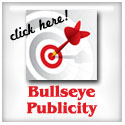The most effective way to get your message to the media is to target the most interested reporters and avoid the ones who aren’t interested.
Sounds simple, but you’d be surprised how often small businesses blast press releases and pitch letters to any and every reporter
they happen to find on a generic media list. Reporters hate this. If you can personalize a pitch or target a press release, you’ll stand a much better chance of being quoted.
To make the best use of your time – and not waste a reporter’s time, here are 10 tips to selecting an effective media list.
1. Is it correct? Make sure the information is correct. It won’t help you to find that there are misspellings, wrong phone numbers or other errors.
2. Is it up to date? Sounds simple, but you’d be surprised at how many sites on the Internet sell outdated information. Ensure that the information is updated at least every quarter. There’s a lot of turnover in the media. An old list is a worthless list.
3. Does it contain complete information? A list should have name, title, publication or media outlet, email, phone and street address at a bare minimum. Give bonus points if the list shows you what topics the reporter covers in detail. For example, buying a list of reporters interested in women’s issues is a start, but how will you know if the reporter is interested in women’s politics, women’s health issues or women’s family and relationship issues? There’s a big difference! Give bonus points to a list that has relevant data, such as links to articles the reporter has written. A good list provider would have personal information about the reporter’s focus and slant so you know what angle to take. You won’t get this from a bare-bones list. You want a full-featured database.
4. Sortable. Ask for the list on a spreadsheet so you can sort on any number of fields, such as city and state, or type of publication. This can be useful if you are going to be in a new city and want to target the media there.
5. Informs you of the type of media outlet. You’d pitch a TV station differently than a print reporter, so make sure the list has this kind of information available. Today, you’d want a list that identifies print, TV, Radio and online media.
6. Contains website address. Every media outlet has a website today. You can research the reporters and the media by going to the website so you know exactly what they cover and how they cover it. Doing this research will help you pitch your story more effectively.
7. Circulation figures for print publications. This number will help you identify the market leaders ands the smaller players.
8. International contacts. The world is shrinking today. If your product or service can be of use to people around the world, then you should contact reporters at other countries.
9. Language spoken. If you stick to the U.S. media, this won’t be as important, but if you pitch international reporters, some will speak English and some will not. In fact, some international media do have correspondents in the US who speak English. Those would be the ones you might want to target.
10. Preferred contact method. How does a reporter want to be contacted? By email? By phone? By fax? By regular mail? Knowing this answer will help you get on their good side!
If you ask these questions before you buy a media list, you’ll save yourself a lot of time and confusion. And you will have a better chance to get the coverage you seek.
I’ve created a new business unit that sells media lists. You can find great lists at BullsEyePublicity.com
Want to learn how to pitch reporters effectively? Download my special report “REVEALED: The Quick And Easy Way To Get Publicity From Reporters And Bloggers Through Social Media And Press Releases!” http://www.bullseyepublicity.com/reporters/ For the most up-to-date, full-featured media database available, please visit www.BullsEyePublicity.com
This article can be reprinted on your webiste or ezine.


 Save time
Save time

Leave A Comment